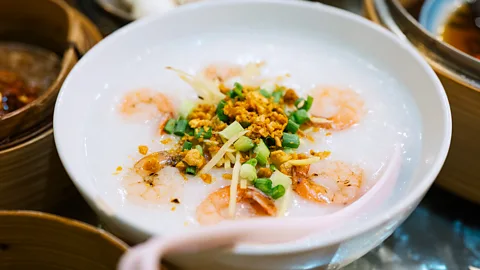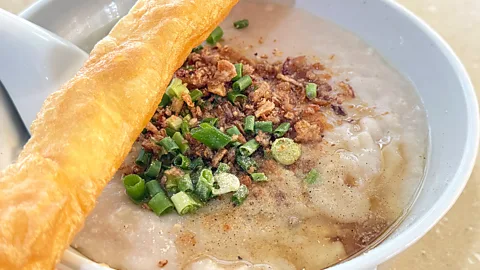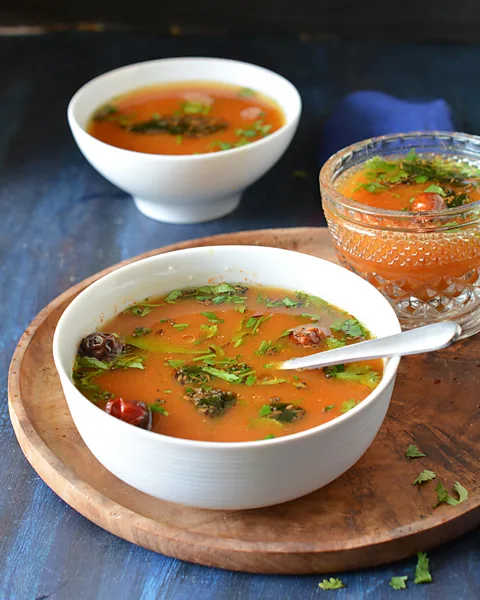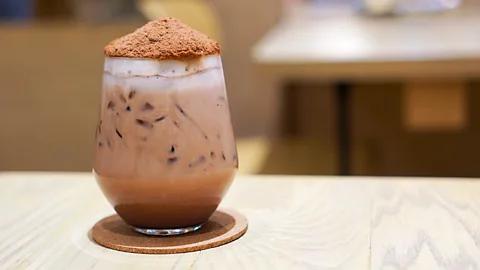The dishes Singaporeans turn to when illness strikes
 Getty Images
Getty ImagesFood is life for this meal-obsessed island, especially when you're feeling poorly – including a spicy soup that soothes flu symptoms and a beloved chocolate drink that brings comfort.
A few years ago, my girlfriend and I landed in Singapore after a winter holiday in Europe. Coughing, dizzy, our throats rusty and inflamed, we were far from well. But help was at hand. My (future) Singaporean mother-in-law came to the rescue, stocking our fridge with liquid medicine: congee. We spooned the thick, savoury rice porridge down our throats, feeling a little better with every swallow.
Warm and filling but gentle on the stomach, in good times congee is a power dinner in and of itself, and endlessly remixable. You can top it with a runny egg, chopped chives and coriander or neon splashes of garlic-chilli oil, and eat like a king. Or when sick, you can cut the tempting add-ons to a bare minimum and still be left with the soothing starch and heat. No wonder congee and its cousins are a key flu go-to in Singapore, Malaysia, China, South Korea – almost any place in East Asia where rice is a staple.
So strong is this porridge's connection to illness that some people can only stomach it when they're under the weather. Like Yuri Cath, a Japanese Indonesian who recently became a Singaporean citizen. "I had a negative association with congee for the longest time because I only had it when I was sick," she says, echoing a sentiment of many locals. "So, having it kind of made me feel ill." Not for long though, she laughs – the flavours won her over again, "and I love congee now".
 Getty Images
Getty ImagesIt's tempting to call congee the king of flu food, but this is Singapore, one of the most culinary-obsessed nations on Earth, and competition is fierce. A literal melting pot, the island's official languages are English, Tamil, Malay and Mandarin, representing the many cultures that form its core population. Each brings with it enough comfort dishes to soothe an army.
Where to eat yourself well in Singapore
Congee: Variety is the name of the game at Mui Kee Congee, where your porridge can come loaded with sliced pork, beef, fish balls or abalone, to name just a few options.
Rasam: Banana Leaf Apolo boasts several locations, including one in the heart of Singapore's Little India. Their menu is extensive, but leave room for this stomach-settling dish.
Tamarind: Looking for a food souvenir? Visit DriedFoodSG, a multi-generation business brimming with dried goods, including tamarind paste or slices, which can be added to stews for an unmistakable flavour boost.
Bak kut teh: Multiple businesses fight for the claim of best bak kut teh on bustling Balestier Road, including Kai Juan Eating House and the aptly named Balestier Bak Kut Teh. The latter is open 24 hours a day.
Milo: Head to Toast Box, a local cafe chain with more than 80 outlets famed as a popular pre-work breakfast spot. Order Milo hot or cold with kaya toast (bread with sweet coconut spread) on the side. A sugary but comforting pick-me-up.
Hippocrates would have liked this nation of six million hungry souls. The Ancient Greek thinker and physician, who once said, "Let food be thy medicine and medicine be thy food," could witness his words come alive as a daily habit in Singapore's restaurants, homes and 120 hawker centres boasting 6,000 stalls. Below are just some of the health-giving dishes and ingredients Hippocrates would approve of.
The solace of tamarind
Singaporean Syazana Izzati has vivid memories of her mother taking care of her when she was a child. Not with prescription pills, but with a long-held Malay practice that uses food as medicine.
"Whenever my siblings and I were running a fever, she used to do this thing where she'd wet our foreheads and hair," Izzati recalls. "As we were lying down on bed, with a towel placed on our brow, she'd wet it with tamarind water." Why tamarind, or asam as it's known in Malay? "Because it has cooling effects," she explains, "and lowers the body temperature."
Traditional Malay Medicine, like many ancient healing methods across Asia, leans deeply on jamu, or herbal and plant-based treatments like Izzati's fever poultice. "These days, I just rely on painkillers," she laughs. But that may change, she says. Should she have children, she'll turn to tamarind on their feverish days – just like her mother and grandmother before her.
But tamarind is too popular to be used as a poultice alone. Some ingredients are so revered they crop up in other healing dishes, from cultures thousands of miles away.
Life-giving bowls of broth
Some 5% of Singapore's population is made up of people with Indian Tamil heritage, who regularly turn to one of the tastiest flu cures you can fit in a bowl. Colourful but light, rasam, a broth originating in South India, is more than the sum of its parts. Its base consists of spices like pepper, turmeric and cumin along with garlic, onions and tomatoes – and, yes, tamarind again, in this case acting as a souring agent that gives the broth its addictive tart flavour. As a paper by two Indian medical researchers notes, rasam's ingredients are so therapeutic that the dish constitutes a "functional food", whose ingredients provide benefits above and beyond their nutritional value.
Rasam's turmeric alone, the researchers explain, offers antimicrobial, antioxidant and anti-inflammatory properties – perfect for soothing any ails. Not surprisingly, they add that rasam is "an ideal recipe subscribing to the principles laid by Indian system[s] of medicine such as Ayurveda and Siddha". As local blogger Miss Vanda noted when she shared a rasam recipe online, "This soup is a perfect remedy for flu," she wrote, calling it "especially good for sore throats".
 Getty Images
Getty ImagesLike many ancient foods, the broth comes with a legend attached to it, one that bolsters rasam's reputation. Troubled by his ailing son's health and waning appetite, an ancient king of Madurai in Tamil Nadu province offered a reward for anyone who could make his child eat. One enterprising chef presented a humble bowl of rasam, which was promptly slurped up by the patient. Needless to say, the boy was soon healed.
Hot-and-cold healing
Another broth with a historic backstory is bak kut teh, or pork rib soup. Made with long-simmered pork bones, lashings of pepper and a cornucopia of herbs, this salty, fatty meal was popular with Chinese coolies who came to Singapore in the 19th Century. Bak kut teh, which translates to "meat bone tea", nourished many a labourer before their gruelling day.
World's Table
BBC.com's World's Table "smashes the kitchen ceiling" by changing the way the world thinks about food, through the past, present and future.
Rasam's turmeric alone, the researchers explain, offers antimicrobial, antioxidant and anti-inflammatory properties – perfect for soothing any ails. Not surprisingly, they add that rasam is "an ideal recipe subscribing to the principles laid by Indian system[s] of medicine such as Ayurveda and Siddha". As local blogger Miss Vanda noted when she shared a rasam recipe online, "This soup is a perfect remedy for flu," she wrote, calling it "especially good for sore throats".
Like many ancient foods, the broth comes with a legend attached to it, one that bolsters rasam's reputation. Troubled by his ailing son's health and waning appetite, an ancient king of Madurai in Tamil Nadu province offered a reward for anyone who could make his child eat. One enterprising chef presented a humble bowl of rasam, which was promptly slurped up by the patient. Needless to say, the boy was soon healed.
Hot-and-cold healing
Another broth with a historic backstory is bak kut teh, or pork rib soup. Made with long-simmered pork bones, lashings of pepper and a cornucopia of herbs, this salty, fatty meal was popular with Chinese coolies who came to Singapore in the 19th Century. Bak kut teh, which translates to "meat bone tea", nourished many a labourer before their gruelling day.
Today it remains a popular pick-me-up from the flu and is prized particularly for its decongestant properties. Bak kut teh is often eaten late at night, when the day is cooler. That's because it's considered a "heaty" soup in Traditional Chinese Medicine (TCM) due to its herbal make-up. The spectrum of internal "heatiness" and "cooling" are core concepts within TCM, a popular practice in Singapore. Excessive heatiness, for example, may see the body erupt in a fever, sore throat and irritability, while the inverse can lead to paleness and fatigue. The key is to balance your warm yang energy with yin, its cooler counterpart.
Ace Tan, head chef at the newly opened fine-dining restaurant ASU, is a strong believer in this balance. His childhood was steeped in the ancient health system: Ace would often visit TCM stores run by his aunts and uncles. It spurred a passion in him to understand what ingredients affected the body, and how. "The practice of consuming specific ingredients during each season is deeply rooted in the Asian philosophy of the five elements," Ace says: "wood, fire, earth, metal and water. These elements are intricately connected to our body systems. By consuming certain ingredients, we nourish specific body parts, ensuring a continuous cycle of cultivation and overall well-being."
So how does Ace cool himself down when balance is disrupted? "I do have a strong affiliation towards two drinks in particular," he says, both commonly drunk as teas: "chrysanthemum and barley, as they help mitigate the heat of my body system, preventing sore throats and fever."
Cocoa means comfort
Sometimes, however, you just need comfort above all. That's where Milo comes in, a chocolate drink sold in practically every hawker centre in town. The brand is so beloved that a paper at the National University of Singapore Centre for Governance and Sustainability dryly noted: "It has even humorously been suggested that Milo flows through the veins of Singaporeans."
 Getty Images
Getty ImagesThey're not wrong. During the Covid-19 pandemic, ad-hoc medical centres gave thousands of patients a care package with critical necessities such as toothpaste, crackers – and sachets of Milo powder.
Though it originated in Australia in the 1930s, Milo became popular in many British colonies in Asia, including Singapore. In a 2019 lecture at the National Museum of Singapore, historian Dr Geoffrey Pakiam explained how, once the island achieved independence in the mid-1960s (first from Britain, and then from the Federation of Malaysia, which it briefly joined), Milo was marketed "as a national drink". In 1984, Milo began to be manufactured locally as well, further cementing a homegrown connection with the beverage.
What makes this best-selling drink such a treat for the poorly? In part, it's because Milo is an embedded part of childhood, served at school canteens, birthday parties and picnics. That connection continues as people age or join mandatory National Service (NS). Loong Lim, who served his NS decades ago, shares that "for a lot of guys, Milo will still bring back memories of the night snack you get in the army, when training ends late." Drunk by young Singaporeans drenched in sweat and mud, Milo has revived many a tired soldier, who will likely serve it to their child one day should illness strike. Followed, perhaps, by a soothing bowl of congee.
--
If you liked this story, sign up for The Essential List newsletter – a handpicked selection of features, videos and can't-miss news, delivered to your inbox twice a week.
